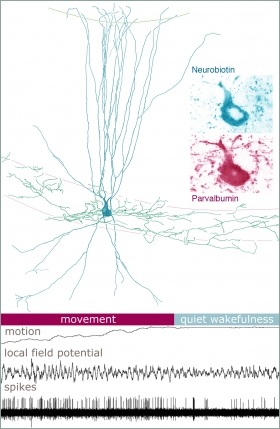Nat. Neurosci. 2012;15(9):1265-71. 10.1038/nn.3176
Behavior-dependent specialization of identified hippocampal interneurons.
Full text PDF download:
Abstract:
A large variety of GABAergic interneurons control information processing in the hippocampal circuits governing the formation of neuronal representations. Whether distinct hippocampal interneuron types contribute differentially to information processing during behavior is not known. We employed a new technique for recording and labeling interneurons and pyramidal cells in drug-free, freely moving rats. Recorded parvalbumin-expressing basket interneurons innervated somata and proximal pyramidal cell dendrites, whereas nitric oxide synthase- and neuropeptide Y-expressing ivy cells provided synaptic and extrasynaptic dendritic modulation. Basket and ivy cells showed distinct spike-timing dynamics, firing at different rates and times during theta and ripple oscillations. Basket, but not ivy, cells changed their firing rates during movement, sleep and quiet wakefulness, suggesting that basket cells coordinate cell assemblies in a behavioral state-contingent manner, whereas persistently firing ivy cells might control network excitability and homeostasis. Different interneuron types provide GABA to specific subcellular domains at defined times and rates, thereby differentially controlling network activity during behavior.